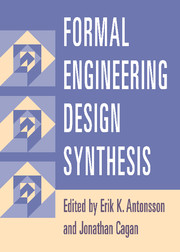Book contents
- Frontmatter
- Contents
- Contributing Authors
- Foreword
- Preface
- Introduction
- 1 Vitruvius Redux
- 2 How to Calculate with Shapes
- 3 Engineering Shape Grammars
- 4 Creating Structural Configurations
- 5 Microsystem Design Synthesis
- 6 Function-Based Synthesis Methods in Engineering Design
- 7 Artificial Intelligence for Design
- 8 Evolutionary and Adaptive Synthesis Methods
- 9 Kinematic Synthesis
- 10 Systematic Chemical Process Synthesis
- 11 Synthesis of Analog and Mixed-Signal Integrated Electronic Circuits
- 12 Mechanical Design Compilers
- 13 Scientific Discovery and Inventive Engineering Design
- Index
3 - Engineering Shape Grammars
Where We Have Been and Where We Are Going
Published online by Cambridge University Press: 10 October 2009
- Frontmatter
- Contents
- Contributing Authors
- Foreword
- Preface
- Introduction
- 1 Vitruvius Redux
- 2 How to Calculate with Shapes
- 3 Engineering Shape Grammars
- 4 Creating Structural Configurations
- 5 Microsystem Design Synthesis
- 6 Function-Based Synthesis Methods in Engineering Design
- 7 Artificial Intelligence for Design
- 8 Evolutionary and Adaptive Synthesis Methods
- 9 Kinematic Synthesis
- 10 Systematic Chemical Process Synthesis
- 11 Synthesis of Analog and Mixed-Signal Integrated Electronic Circuits
- 12 Mechanical Design Compilers
- 13 Scientific Discovery and Inventive Engineering Design
- Index
Summary
INTRODUCTION
Shape grammars (Stiny, 1980; see also Chapter 2 in this book), originally presented in the architecture literature, have successfully been used to generate a variety of architectural designs including irregular Chinese lattice designs (Stiny, 1977), villas in the style of Palladio (Stiny and Mitchell, 1978), Mughul gardens (Stiny and Mitchell, 1980), prairie houses in the style of Frank Lloyd Wright (Koning and Eizenberg, 1981), Greek meander patterns (Knight, 1986), suburban Queen Anne houses (Flemming, 1987), and windows in the style of Frank Lloyd Wright (Rollo, 1995). The derivation of the grammars and the designs generated by their use have revealed systematic logic in the generation of classes of architectural designs. For example, Koning and Eizenberg's Frank Lloyd Wright prairie house grammar demonstrated that, through the application of a relatively simple set of predefined rules, an infinite number of designs illustrative of Frank Lloyd Wright's own prairie houses can be created. One could question whether Wright consciously or unconsciously used such a set of rules to generate his houses; or one could not care but rather just marvel at the power of a simple rule set, based in the geometry of shape, to generate such rich and representative designs.
We can next ask, if the logic of architecture can be revealed and capitalized upon to represent and generate creative designs within known styles, can the same be done in engineering?
- Type
- Chapter
- Information
- Formal Engineering Design Synthesis , pp. 65 - 92Publisher: Cambridge University PressPrint publication year: 2001
- 24
- Cited by



